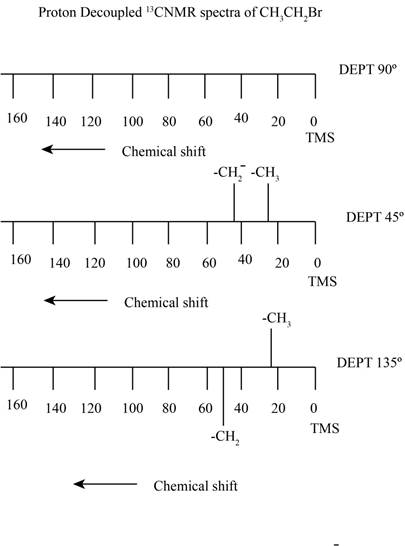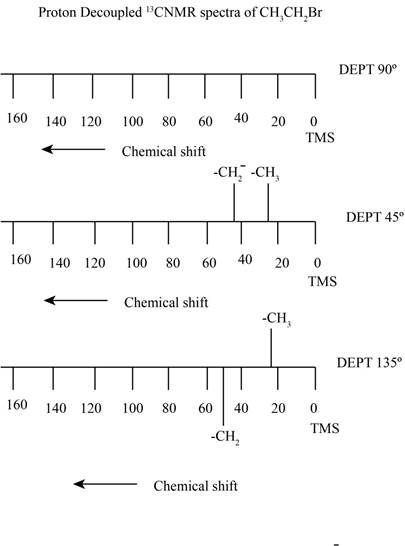
Concept explainers
Interpretation:
The proton decoupled 13C NMR spectra of ethyl bromide is to be stated.
Concept introduction:
The 13C NMR spectroscopy is similar kind of spectroscopy to NMR the only difference them is that it is used to detect the presence of 13C nucleus. The
Answer to Problem 13.63AP
The proton decoupled 13CNMR spectra of ethyl bromide is shown below.

Explanation of Solution
The carbon atom exists in two isotopes 12C and 13C their relative intensity 0.989 and 0.011 respectively. The bromine atom exists in two isotopes 79Br and 81Br their relative intensity (0.505) and (0.495) respectively. In the given case consider 79Br isotope only. The hydrogen atom exists basically in 1H isotope with maximum intensity. The general formula for calculation of relative intensity is shown below.
Relative intensity=Multiplication of natural abundance of elements …(1)
The relative intensity for the molecule in which no 13C isotope is present is calculated by substituting the value of the element’s abundance in equation (1) as shown below.
Relative intensity=((Natural abundance of 1H)5×(Natural abundance of 12C)2×(Natural abundance of 79Br))=(0.999)5×(0.989)2×(0.505)=0.995×0.9781×0.505=0.491
The coefficient represents the number of atoms present of each element. Here the possibility of two 12C is present. The relative intensity for the molecule in which one 12C and one 13C isotope are present is calculated by substituting the value of elements abundance in equation (1) as shown below.
Relative intensity=((Natural abundance of 1H)5×2(Natural abundance of 12C)×(Natural abundance of 13C)×(Natural abundance of 79Br))=(0.999)5×((0.989)×(0.011)×2)×(0.505)=(0.995)×(0.989)×(0.011)×2×(0.505)=0.0109
Here, 12C and 13C both can be present in vice-versa form that is why coefficient 2 is multiplied in the calculation. Similarly, the relative intensity for the molecule in which two 13C isotopes are present is calculated by substituting the value of elements abundance in equation (1) as shown below.
Relative intensity=((Natural abundance of 1H)5×(Natural abundance of 13C)2×(Natural abundance of 79Br))=(0.999)5×(0.011)2×(0.505)=(0.995)×(0.000121)×(0.505)=6.079×10−5
Here the possibility of two 13C is present. Terefore, the relative ratio is calculated by comparing relative intensity as shown below.
no 13C:one 13C:two 13C0.491:0.0109:6.079×10−5
The compound ethyl bromide contains two types of proton containing carbon. It gives rise to a quartet signal of −CH3 carbon and a triplet signal of −CH2− carbon. In the given case, proton decoupled spectra is reported which means a phenomena DEPT is used. DEPT is expanded as distortionless enhancement by polarization transfer which is used to differentiate 1°, 2°, 3° and 4° carbon presence. Three different types of DEPT is used DEPT 90°, 45° and 135°. DEPT 90° give a signal of −CH carbon only. DEPT 45° give signals of all carbon present. DEPT 135° give signals of −CH and −CH3 in the upper direction and a signal of −CH2− carbon in the opposite direction. The proton decoupled 13CNMR spectra of ethyl bromide is shown below.

Figure 1
The proton decoupled 13C NMR of ethyl bromide is shown in Figure 1.
Want to see more full solutions like this?
Chapter 13 Solutions
Organic Chemistry, Ebook And Single-course Homework Access
- 11 Organic Chemistry Organic Nomenclature Practice Name/Functional Group n-butane Formula Structural Formula (1) C4tt10 H3C C- (2) CH3CH2CH2 CH 3 H₂ -CH3 Н2 name & functional group (1) and (2) OH H₁₂C Н2 name only (1) and (2) name only (1) and (2) H₁C - = - CH₂ Н2 HC=C-C CH3arrow_forwardUnder aqueous basic conditions, nitriles will react to form a neutral organic intermediate 1 that has an N atom in it first, and then they will continue to react to form the final product 2: NC H₂O он- H₂O 1 2 OH Draw the missing intermediate 1 and the final product 2 in the box below. You can draw the two structures in any arrangement you like. Click and drag to start drawing a structure.arrow_forwardAssign these COSY Spectrumarrow_forward
- Assign these C-NMR and H-NMR Spectrumarrow_forwardPredict the product of this organic reaction: IZ + HO i P+H₂O Specifically, in the drawing area below draw the skeletal ("line") structure of P. If there is no reasonable possibility for P, check the No answer box under the drawing area. No Answer Click and drag to start drawing a structure. ☐ :arrow_forwardPredict the products of this organic reaction: 0 O ----- A + KOH ? CH3-CH2-C-O-CH2-C-CH3 Specifically, in the drawing area below draw the condensed structure of the product, or products, of this reaction. (If there's more than one product, draw them in any arrangement you like, so long as they aren't touching.) If there aren't any products because this reaction won't happen, check the No reaction box under the drawing area. No reaction Click anywhere to draw the first atom of your structure. X ⑤ èarrow_forward
- Predict the products of this organic reaction: O CH3 + H2O + HCI A A? CH3-CH2-C-N-CH3 Specifically, in the drawing area below draw the condensed structure of the product, or products, of this reaction. If there's more than one product, draw them in any arrangement you like, so long as they aren't touching. If there aren't any products because this reaction won't happen, check the No reaction box under the drawing area. No Reaction Click anywhere to draw the first atom of your structure.arrow_forwardWhat is the missing reactant in this organic reaction? R+ HO-C-CH2-CH3 0= CH3 CH3 —CH, C−NH—CH CH3 + H₂O Specifically, in the drawing area below draw the condensed structure of R. If there is more than one reasonable answer, you can draw any one of them. If there is no reasonable answer, check the No answer box under the drawing area. Note for advanced students: you may assume no products other than those shown above are formed. No Answer Click anywhere to draw the first atom of your structure. €arrow_forward个 CHEM&131 9267 - $25 - Intro to Mail - Hutchison, Allison (Student x Aktiv Learnin https://app.aktiv.com Draw the product of the reaction shown below. Ignore inorganic byproducts. + Na2Cr2O7 Acetone, H2SO4 Type here to search Dryng OH W Prarrow_forward
- Predict the products of this organic reaction: OH + NaOH A? Specifically, in the drawing area below draw the skeletal ("line") structure of the product, or products, of this reaction. (If there's more than one product, draw them in any arrangement you like, so long as they aren't touching.) If there aren't any products because this reaction won't happen, check the No reaction box under the drawing area. No reaction Click and drag to start drawing a structure. ✓ Sarrow_forwardPredict the products of this organic reaction: CH3-C-O-CH2-CH2-C-CH3 + H₂O ? A Specifically, in the drawing area below draw the condensed structure of the product, or products, of this reaction. (If there's more than one product, draw them in any arrangement you like, so long as they aren't touching.) If there aren't any products because this reaction won't happen, check the No reaction box under the drawing area. No reaction Click anywhere to draw the first atom of your structure. :☐ darrow_forwardDE d. Draw an arrow pushing mechanism for the following IN O CI N fo 人 P Polle DELL prt sc home end ins F5 F6 F7 F8 F9 F10 F11 F12arrow_forward
 Organic Chemistry: A Guided InquiryChemistryISBN:9780618974122Author:Andrei StraumanisPublisher:Cengage Learning
Organic Chemistry: A Guided InquiryChemistryISBN:9780618974122Author:Andrei StraumanisPublisher:Cengage Learning
